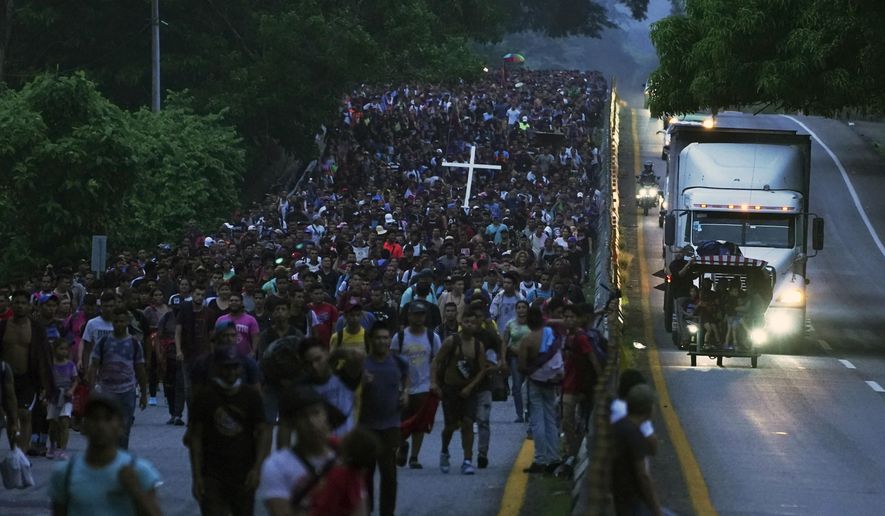HUEHUETAN, Mexico (AP) — Several thousand migrants continued walking before dawn through southern Mexico Tuesday, covering ground before the heat of the day and while authorities showed no signs yet of trying to stop them.
The largest migrant caravan of the year provided a live illustration to regional leaders meeting in Los Angeles this week for the Summit of the Americas of the challenges governments face in managing immigration flows.
Many of the migrants themselves had more pressing concerns, such as getting their families to safety and finding work.
Eymar Hernández Benavides was a state police officer in Venezuela. In January, his extended family, divided between Tachira and Barquisimeto, began a group chat on a messaging platform. For three months they aired their grievances - product scarcity, high food prices, constant electrical blackouts - and planned their exit.
Hernández sold his car and other belongings to fund the two-week odyssey from Venezuela to Mexico, including through the harrowing jungle-clad Darien Gap that separates Colombia and Panama. That was hardest part for his wife, Jenny Villamizar. Not just the swollen rivers, rain, wildlife and thick vegetation, but watching their three children suffer.
More than 130,000 migrants crossed the Darien Gap in 2021. Since January, more than 34,000, including 18,000 Venezuelans, have crossed there, according to Panama’s National Migration Service.
On Tuesday, Hernández walked up a rural highway in southern Mexico with 17 relatives, including his wife and their children, the 3-year-old in a stroller.
“It’s not Venezuela, it is the president, Venezuela works, it is a paradise, we didn’t want to leave our country,” Hernández said, referring to President Nicolás Maduro, who was not invited to the summit.
He said they want the U.S. to help resolve the crisis in Venezuela so they can return, but in the meantime they want asylum in the United States. They did inquire about asylum in Mexico in Tapachula, but were given an appointment for July. Through odd jobs they earned enough money to rent just one room, so they decided to join the caravan instead.
Their goal for Tuesday was to make it to Huixtla, Chiapas, a town still more than 1,000 miles from the closest point on the U.S. border. Mexican National Guard and immigration agents were visible along the route, but had not made an effort to stop the migrants. They did make those who had gotten rides on truck trailers get off and walk, apparently hoping to tire them out.
María José Gómez, 24, and Roselys Gutierrez, 25, a couple also from Venezuela, said they had left Colombia after experiencing homophobia there and suffering physical attacks.
They arrived in the southern Mexican city of Tapachula near the border with Guatemala a week ago and joined the caravan when it left Monday. Gómez was walking Tuesday with the rainbow flag and Gutierrez with that of Venezuela.
“We are very tired and want this torment to be over,” Gómez said. “We have walked a lot on the trip. We passed through the Darien jungle and have been in seven countries counting this one.”
Mexico has tried to contain migrants to the south, far from the U.S. border. But many have grown frustrated there by the slow bureaucratic process to regularize their status and the lack of job opportunities to provide for their families.
Mexico’s asylum agency has been overwhelmed with requests in recent years as policies leave migrants few other options than to request asylum so they can travel freely. Last year, Mexico received more than 130,000 asylum requests, more than triple the year before. This year, requests are already running 20% above last year.
The phenomenon of migrant caravans took off in 2018. Previously, smaller annual caravans moved through Mexico to highlight migrants’ plight, but without the stated goal of reaching the U.S. border.
But then several thousand migrants began walking together, betting on safety in numbers and a greater likelihood that government officials would not try to stop them. It worked at first, but more recently the Guatemalan and Mexican governments have been far more aggressive in moving to dissolve the caravans before they can build momentum.
While the caravans have garnered media attention, the migrants traveling in them represent a small fraction of the migratory flow that carries people to the U.S. border every day, usually with the help of smugglers.
The Biden administration had hoped to hammer out a regional agreement on managing migrant flows at the summit, but the presidents of Mexico, Guatemala, Honduras and El Salvador are not attending, a notable absence of some of the leading migrant-sending and transit countries.
Keira Lara, a 30-year-old from El Salvador, trudged down the highway Tuesday with three of her four children. She had just arrived in Mexico a week earlier and only heard about the summit once she joined the caravan Monday. She said government officials had demanded money from her at every border they crossed.
Of the leaders meeting in Los Angeles this week she asked “that they let us pass, that there isn’t so much corruption in governments, because that’s why people migrate.”




Please read our comment policy before commenting.